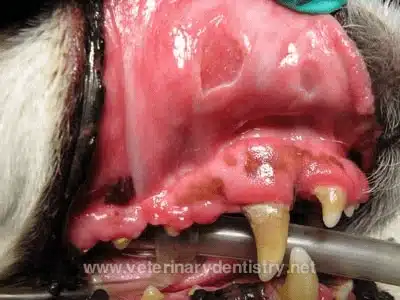
At the Veterinary Dental Center of Atlanta, we understand the importance of providing the best possible care for dogs suffering from Chronic Ulcerative Paradental Stomatitis (CUPS). This painful condition is characterized by inflammation of the gingiva (gum tissue), the buccal (cheek) and palatal mucosa, lip tissue, and tongue tissue, as well as significant ulcers on tissue that comes in contact with the teeth.
Diagnosis of CUPS can be challenging as it can mimic other oral diseases. Our team of highly trained and experienced veterinary dental providers are experts in CUPS diagnosis and treatment, and we use the latest technology and equipment to ensure that your pet receives the best possible care.
The treatment of CUPS is often multifaceted and may include dental cleaning, extractions, and oral surgery, as well as medical management with the use of antibiotics, anti-inflammatory medication, and immunomodulatory therapy. Our team will work closely with you to create a personalized treatment plan that meets your pet’s specific needs.
At the Veterinary Dental Center of Atlanta, we are committed to providing the best possible care for dogs suffering from CUPS. Trust our team of experts for accurate diagnosis and effective treatment for your furry friend.
Some studies show that Maltese, Cavalier King Charles Spaniel, Greyhounds, and Labrador retrievers are more susceptible and have a higher reported prevalence of CUPS than the general canine population.
What causes canine stomatitis?
Although the exact cause of this condition is variable, detecting what specifically causes CUPS for each dog can be unclear.
In the majority of cases, it is believed that the dog’s immune system is overreacting to bacteria in plaque. This bacteria can trigger an antigenic response (immune response) due to the chronic exposure of pathogens (bacteria) in the immune system.
Normally a canine’s immune system keeps this in check, but patients that suffer from CCUS have an immune response that is excessive. Local inflammatory reactions are elevated in these individuals due to even a small amount of plaque formation.
Although CUPS’s specific pathogenesis (cause) isn’t known, it is helpful to consider that, for whatever reason, these patients cannot tolerate bacterial plaque on their crowns. Minor plaque accumulations can cause an overly destructive and painful ulcerative inflammatory response.
What does Canine Chronic Ulcerative Stomatitis (CCUS) in dogs look like?
The initial complaints may variably include any of the following:
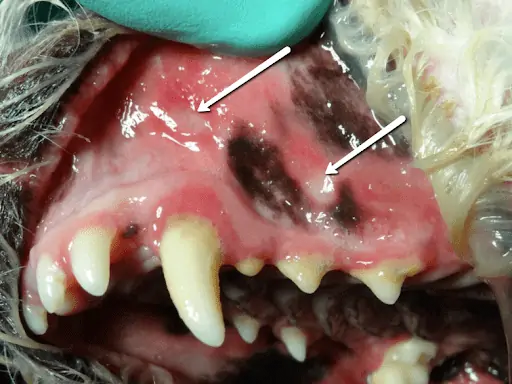
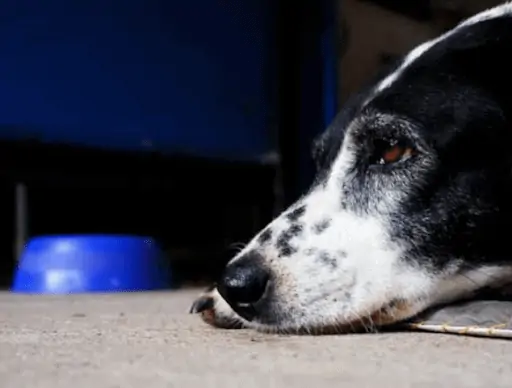
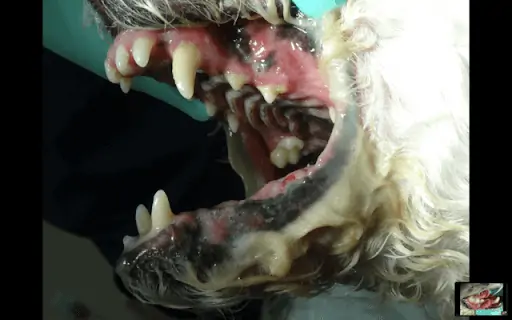
Ulceration or ulcers adjacent to the tissues of the teeth
Ulceration or ulcers adjacent to the tissues of the teeth
Ulceration or ulcers adjacent to the tissues of the teeth
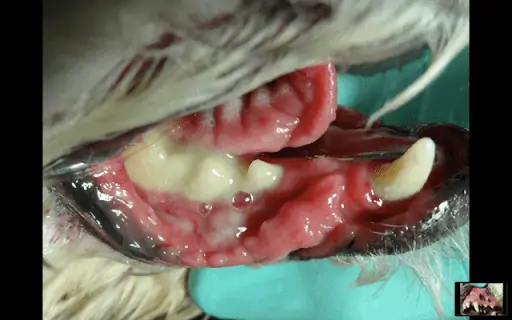
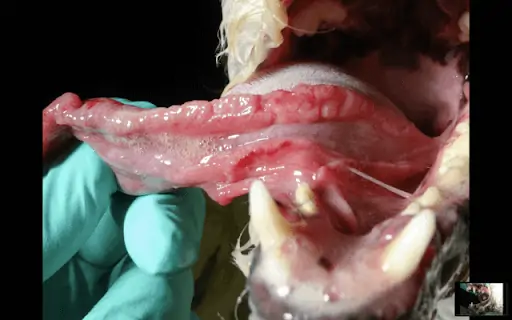
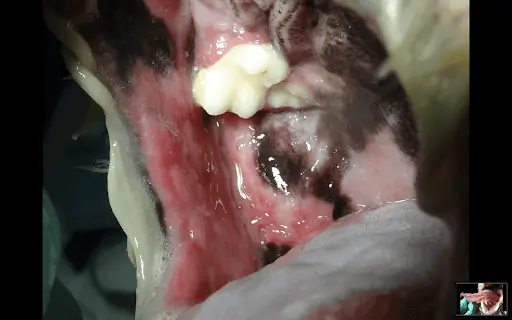
Lip fold dermatitis (inflammation that reaches the skin of the dog’s lip folds)
Ulceration of the tongue
Severe inflammation of caudal oral mucosa (back of the mouth)
Physical Examination
Several autoimmune inflammatory disorders can appear somewhat similar to Canine Chronic Ulcerative Stomatitis (CCUS). These include specific autoimmune disorders such as bullous pemphigoid and pemphigus vulgaris.
These conditions can sometimes lead to oral lesions, but they are also frequently associated with disorders of the skin non-oral mucous membrane lesions. A complete physical examination of the entire patient is, therefore, necessary to determine if other areas of involvement are present.
In any case, where there is suspicion that one of these other conditions might be present, a biopsy is indicated. With that in mind, the appearance of all of the characteristics as shown in the images above is generally diagnostic of CUPS, and biopsy is generally not needed.
CBCs and biochemistry tests are recommended as part of a comprehensive preoperative exam. The only significant abnormalities commonly associated with CUPS are polyclonal hypergammaglobulinemia (increase in blood proteins) and mild neutrophilic leukocytosis (increase in white blood cells).
Is CUPS difficult to diagnose?
CUPS is one of the most commonly misdiagnosed diseases I see in specialty practice. Commonly mistaken for periodontal disease, patients are wrongly treated by periodic cleaning in the hospital and endless forms of home oral hygiene. This only prolongs the pain that these poor patients endure, mostly in silence, until the pet parent seeks a second opinion.
Once the patient reaches a veterinarian that is familiar with this disease it is often an immediate diagnosis with a simple oral exam. Many of these patients, however, have reached a stage of significant pain and won’t permit oral exam. These patients will need to be sedated to evaluate the oral cavity and make the diagnosis.
When I ask veterinarians at my seminars to raise their hand if they know what the condition is in the pictures above. The tragedy for patients suffering from CUPS is that generally, only 30% are familiar with this condition. It is certain that a large number of the other 70% of veterinarians have patients that are currently being treated for periodontal disease instead of CUPS.
How do you treat stomatitis in dogs?
When the scenario above unfolds, and the proper diagnosis is finally made, often it is a huge surprise to the pet parent. Often, treatment for the wrong condition has been going on for years. Pet parents are not only surprised but may feel relief that someone has finally made the proper diagnosis. They may also feel guilt for not seeking another opinion sooner.
Since the only treatment for CUPS or CCUS is the extraction of every tooth that is causing the inflammation many pet parents are not prepared for treatment at that time. This is especially the case when every tooth in the mouth is involved, requiring total mouth extractions.
What can be done between the diagnosis and the proper treatment of CCUS?
Pain Management and Comprehensive Oral Health Assessment and Treatment (COHAT)
Following the correct diagnosis, a treatment plan should be made to extract all teeth associated with oral inflammation. Pain medications and steroidal or non-steroidal antiinflammatories can give patients some relief until surgery an arranged.
A comprehensive oral health assessment (COHAT) under anesthesia will also help to temporarily provide some relief of inflammation. This includes scaling and polishing the teeth to remove the plaque and calculus, periodontal probing of each tooth, charting of each and every tooth, along with intraoral dental radiographs of the whole mouth.
In some cases, the entire mouth is not affected and selective extractions can be done. However periodontal disease may be affecting the bone beneath the gum line and should not be overlooked in teeth adjacent to non-affected tissue.
Although the periodontal disease may be present, most common teeth that need to be extracted due to CUPS are not experiencing bone loss. Most teeth are totally encased with thick bone. Managing the inflamed tissue is also extremely difficult when performing surgical extractions both for bone exposure and suturing post-extraction. It is for this reason that it is recommended that these cases be managed only by those skilled in these procedures. This would include Board Certified Veterinary Dentists and Veterinary Dental Practitioners with significant surgical extraction experience.
Often, even in experienced hands such as Boarded Dentists and Veterinary Dental Practitioners, these procedures may span 3 ½ – 5 hours. Regional nerve blocks and continuous rate analgesic infusions minimize postoperative pain and allow for fewer anesthetic medications making anesthesia much safer.
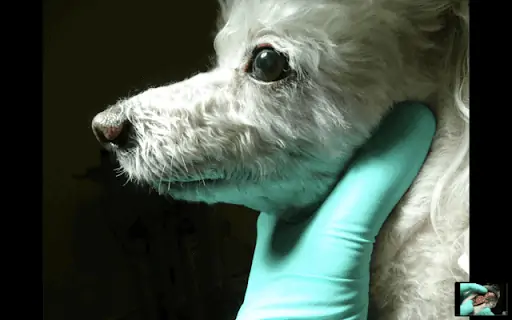
Post-operative image of the patient.
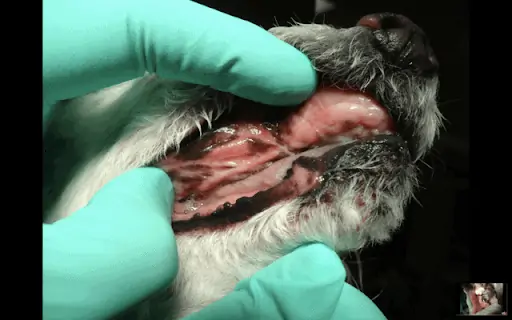
Post-operative image of the patient. Inflammation is gone and the patient is pain-free.
Patients with CCUS that have undergone total-mouth extractions resolve completely, have been free of pain, and require no additional treatment.
Patients that receive selective extractions although pain-free, may develop inflammation adjacent to other teeth later in life. Although this must be differentiated from periodontal disease, keeping in mind the characteristic appearance demonstrated in the images above couple with dental radiographs this can be done relatively easily by the trained professional.
Chronic Ulcerative Paradental Stomatitis and Canine Chronic Ulcerative Stomatitis are the same severely debilitating disease that affects dogs of all ages. Pet parents are advised to watch for signs in their own pets and seek opinions from specialists or Veterinary Dental Practitioners to confirm the diagnosis. Doing so may save years of unnecessary anesthetic episodes to treat periodontal disease when in fact, CUPS or CCUS are the cause of the inflammation.
